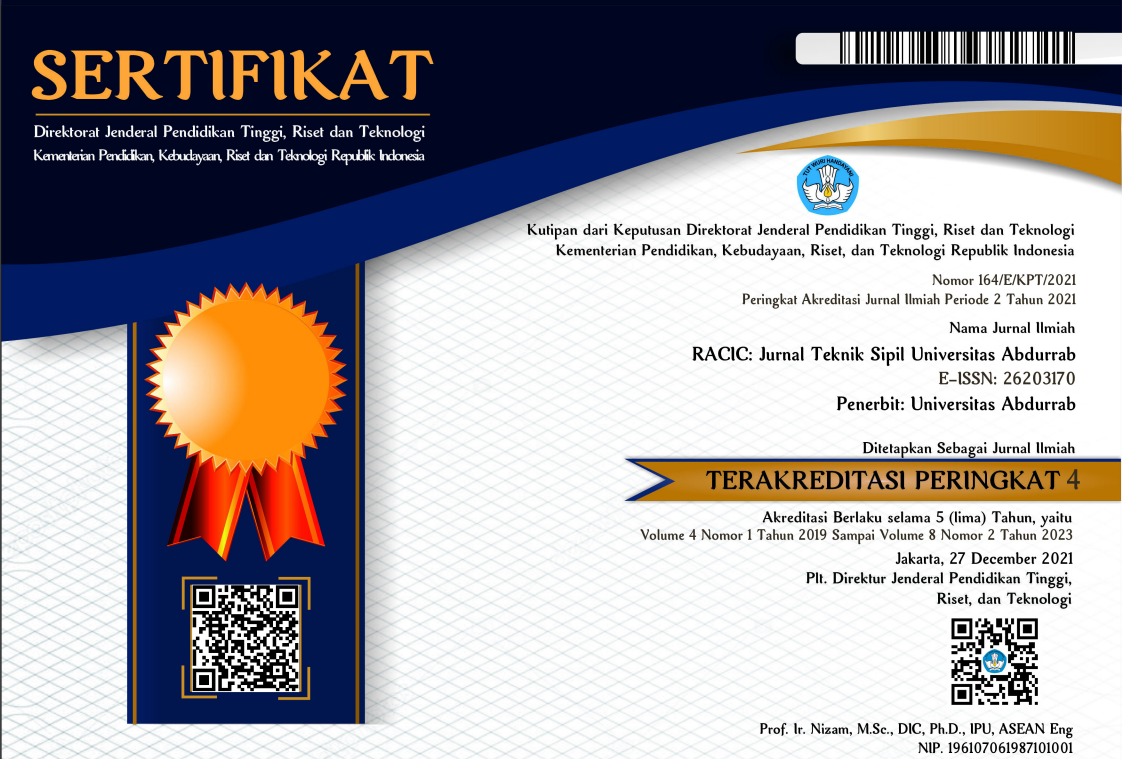STRATEGI PENANGANAN LALU LINTAS PADA KAWASAN CENTRAL BUSINESS DISTRICT (CBD) DI KOTA PEKANBARU BERDASARKAN PENDEKATAN TEKNIS
DOI:
https://doi.org/10.36341/racic.v6i1.1579Keywords:
vissim, central business district, level of serviceAbstract
The problem of congestion in Indonesia is often resolved only by improving / supplying the road network through widening or adding roads. This is a practical strategy to respond to the demand for increased transportation, but this strategy is temporal in nature and actually encourages higher growth rates of motorized vehicles in cities. Traffic management is one of the traffic management strategies that make maximum use of existing transportation infrastructure and facilities. The Central Business District (CBD) or the City Center Region (DPK) is the center of all city activities and a strategic location for city-scale trading activities. One of the traffic problems in Pekanbaru City, especially the activity center area of ​​Jalan Jenderal Sudirman (in front of STC - Jalan Ir Juanda) is the poor performance level of the road both in terms of speed, traffic volume and also the density that occurs on the Jalan Jenderal Sudirman section. . From these problems, the problem solving is through traffic management by applying several scenarios using vissim, namely controlling street vendors, on street parking control, one-way / flow diversion systems and signalized intersection cycle arrangements. The most optimal scenario is to control the parking lot and change the parking angle of Jalan General Sudirman and Jalan Juanda to an angle of 300 and the application of Jalan M. Yamin into a one-way system to Jalan Sudirman and setting the cycle of signalized intersections so that the performance of the road is smaller at the level C (0.45-0.74).
Downloads
References
Direktorat Jenderal Bina Marga, 1997, Manual Kapasitas Jalan Indonesia (MKJI), Departemen Pekerjaan Umum, Jakarta.
Direktorat Jenderal Bina Marga, 2004, Pedoman Pencacahan Lalu Lintas dengan Cara Manual, Departemen Pekerjaan Umum, Jakarta.
Direktorat Jenderal Bina Marga, 2004, Survei Inventarisasi Geometri Jalan Perkotaan, Departemen Pekerjaan Umum, Jakarta.
Hermawan, B. A. (2016). Manajemen dan Rekayasa Lalu Lintas Kawasan CBD Kota Bekasi. Jurnal Pembangunan Wilayah & Kota, 12(1), 27. https://doi.org/10.14710/pwk.v12i1.11454
Heddy R. Agah, 2007, kondisi arus lalu-lintas, kondisi geometrik jalan dan komposisi arus lalu-lintas. Jakarta.
Keputusan Menteri No. 14, 2006, Tentang Manajemen dan Rekayasa Lalu Lintas di Jalan. Jakarta.
Laporan Umum Kota Pekanbaru. (2018). Pola Umum Transportasi Darat Kota Pekanbaru.
Olayiwola, K. O., Olaseni, A. M., & Fashina, O. (2014). Traffic Congestion Problems in Central Business District (CBD) Ikeja, Lagos Metropolis, Nigeria. Research on Humanities and Social Sciences, 4(1), 23–32.
Tamin, O.Z., 2000. Perencanaan dan Permodelan Transportasi, Bandung.
Tamin, O.Z., 2008. Perencanaan, Permodelan, dan Rekayasa Transportasi, Bandung.
Tianzi, C., Shaochen, J., & Hongxu, Y. (2013). Comparative Study of VISSIM and SIDRA on Signalized Intersection. Procedia - Social and Behavioral Sciences, 96 (Cictp), 2004–2010.
Peraturan Menteri Perhubungan No. 96., 2015, Tentang Pedoman Pelaksanaan Kegiatan Manajemen dan Rekayasa Lalu Lintas. Jakarta.
Peraturan Pemerintah no. 32, 2011. Tentang Manajemen dan Rekayasa, Analisa Dampak, serta Manajemen Kebutuhan Lalu Lintas, Jakarta.
Undang-undang Lalu Lintas no. 22., 2009. Tentang Rekayasa Lalu Lintas, Jakarta
Yu, W., Ai, T., & Shao, S. (2015). The analysis and delimitation of Central Business District using network kernel density estimation. Journal of Transport Geography, 45, 32–47. https://doi.org/10.1016/j.jtrangeo.2015.04.008
Downloads
Published
Issue
Section
License
1. Copyright of all journal manuscripts is held by the RACIC : Rab Construction Research
2. Formal legal provisions to access digital articles of electronic journal are subject to the provision of the Creative Commons Attribution-ShareAlike license (CC BY-NC-SA), which means that RACIC : Rab Construction Research is rightful to keep, transfer media/format, manage in the form of databases, maintain, and publish articles.
3. Published manuscripts both printed and electronic are open access for educational, research, and library purposes. Additionally, the editorial board is not responsible for any violations of copyright law.
licensed under a Creative Commons Attribution-ShareAlike 4.0 International License.





